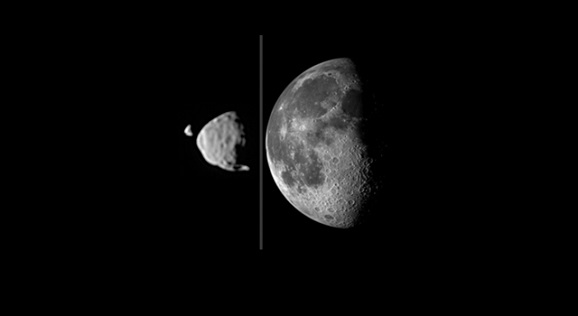Space Always Wins: A Martian Lunar Eclipse And An Exploding Meteor
This article is more than 2 years old
In outer space, even the most trivial events are undoubtedly more important on the grand scale than whatever asinine behavior some pop star engages in. This past week offered stargazers two unique events, one of which we’ve never seen before. That would be the video above, which features the first recorded time a planet’s moon has eclipsed another, via NASA. And the second video, seen below, is of a meteor exploding, thanks to Michael Chung.
Most of the images that come from the Mars rover Curiosity are of rocks and the landscape of the Martian surface. A few weeks ago, NASA turned the rover’s Mastcam instrument up to the sky at a point when extra energy consumption was minimal and it was feasible to catch both of the Red Planet’s moons, the larger Phobos and the smaller Deimos, at the same time.
Seen from the surface of Mars, Phobos appears to be nearly half as wide as the moon we call our own. But that’s only because its orbital distance is much closer to Mars. Phobos actually has a diameter that is less than one percent of our moon. And little by little, its orbit is actually getting closer to Mars, while Deimos is possibly getting farther out.
“The ultimate goal is to improve orbit knowledge enough that we can improve the measurement of the tides Phobos raises on the Martian solid surface, giving knowledge of the Martian interior,” explained Texas A&M’s Mark Lemmon, co-investigator for use of Curiosity’s Mastcam. “We may also get data good enough to detect density variations within Phobos and to determine if Deimos’ orbit is systematically changing.” Here’s a shot of the three moons, as visible from planetary surfaces.
 From these lunar observations, we flap our wings and move on to gawking at meteors. Photographer and digital artist Michael Chung took a time-lapse shot of the recent Perseid meteor shower on August 12, as seen from his backyard in Victorville, California. While it’s described by astronomer Daniel Fischer as “a persistent train after a Perseid fireball, being torn apart by upper atmosphere wind shear,” the rest of us can feel comfortable calling it a meteor blowing the fuck up.
From these lunar observations, we flap our wings and move on to gawking at meteors. Photographer and digital artist Michael Chung took a time-lapse shot of the recent Perseid meteor shower on August 12, as seen from his backyard in Victorville, California. While it’s described by astronomer Daniel Fischer as “a persistent train after a Perseid fireball, being torn apart by upper atmosphere wind shear,” the rest of us can feel comfortable calling it a meteor blowing the fuck up.
You can watch the explosion and resulting debris spray for yourself, four different times. The first two are shown full frame and cropped down, while the second two are cropped mostly around the explosion itself, making it more centered. If anyone has any information regarding the Death Star’s involvement with the explosion of this meteor, please let us know.
2013 Perseids Meteor Shower: Meteor Explosion from Michael Chung on Vimeo.












